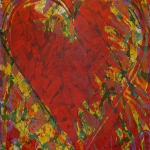Jim Dine American, b. 1935
The New Building, 2013
Woodcut, etching with hand drawing
64 x 47.5"
201609-2725
In 1971 Jim Dine produced the first paintings in which a large heart appears on its own, a device to which he has since returned both on canvas and at...
In 1971 Jim Dine produced the first paintings in which a large heart appears on its own, a device to which he has since returned both on canvas and at regular intervals in his graphic work. It has served him for almost as many reasons as he needs for making art: as a formal device, as a stand-in for the body, as a sexual image, and an emblem of romance, and as a sign of erotic love and desire...The advantages, particularly with such a simple shape, were many: it was impossible to forget, graphically arresting, sufficiently neutral to support a variety of associations, and so flexible as a container for an infinite range of marks, colors and other images that it was unlikely ever to outlive its usefulness. It has certainly continued pumping life into Dine's paintings, drawings, prints and sculptures more than thirty years on. Jim Dine is a major post-war artist whose work ranges from vibrant, large-scale paintings to exquisitely-rendered, romantic drawings and bronze sculpture. Dine's debut on the New York art scene came via several 'happenings' performances along with artists Claes Oldenburg and Robert Whitman in the early 1960s. Since then Dine's name has been inextricably linked with the Pop Art movement, but his diverse body of work defies such easy categorization. Over the past five decades, Dine has created a wide breadth of work: drawings, works on paper, paintings, assemblages, and sculpture. His subjects have included plants, animals, figures, puppets, and self-portraits, and his iconic depictions of hearts, tools, and robes have become the hallmark of his oeuvre. Dine studied at the University of Cincinnati and the Boston Museum School, and received his B.F.A. from Ohio University, Athens, where he was also enrolled in the graduate program. He moved to New York City in 1958, where he had his first group (1959) and solo (1960) exhibitions. Since his first solo exhibition in 1960, Dines paintings, sculptures, photography, and prints have been the subject of nearly 300 solo exhibitions worldwide.
4
of
4



